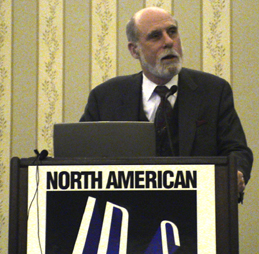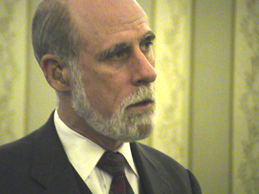"It's Not When but How," Says Vinton Cerf in Keynote at IPv6 Summit
|
June 22, 2004 -- Vinton G. Cerf, who recently joined the Calit² Advisory Board, provided the keynote Wednesday last week to the four-day IPv6 North American Summit, held in Santa Monica, California, June 14-17.
Cerf is widely known as one of the fathers of the Internet. In fact, this year he celebrates the 30th anniversary of publication of the very first paper on the Internet. Published in the IEEE Transactions on Communications (May 1974) and titled "A Protocol for Packet Network Intercommunication," it was co-authored by Cerf and Robert Kahn. According to Cerf's Web site, "Little did we know thirty years ago that this research effort would spawn countless initiatives by individuals and organizations, ultimately world wide, to explore the applications made possible by a network of hundreds of millions of programmable devices, soon to be billions."
"Let me start with my assumptions," began Cerf. He assumed that the 500 attendees were familiar with IPv6, the motivations for adopting it were well known (especially that it will dramatically increase the number of available IP addresses), and that the "uptake" of the technology has been relatively slow, though adoption seems to be picking up speed particularly in Asia and Europe.
Cerf pointed to growth in the use of the Internet starting with 1995 and projecting out to 2015. "At that point, we expect something like 2.6 billion users," he said. "That number will consume a substantial percentage of the number of IP addresses available.
"In the early 1990s," he continued, "there was extreme concern that address space would be consumed within a decade. Now we know that's not likely to happen for another 10 years. But when is not the relevant question. It's enough to know we will, so we need to be planning for that."
The movement to transition to IPv6 is taking place in a very different world than when the Internet was born. Then technologies could be developed from scratch without the need for backward compatibility. Because IPv6 is a new, but likely replacement for, IPv4, it's emerging in the form of sparse pockets of connectivity. "We having to play 'tunneling games,'" said Cerf, "to interconnect parts to run in parallel with IPv4."
Accelerating the need for moving to IPv6 is the phenomenon of wireless hotspots emerging seemingly everywhere. Cert noted that these include places where you might not expect them. He cited "Val's Laundry and Internet" in Belize, which drew laughs from the audience, and the fact that, on a recent trip to Africa, he counted 36 wireless hotspots in a large city in Ghana.
The wide availability of Internet access through wireless will further increase the demand for IP addresses. Currently, such devices include refrigerators, windshield wipers, and picture frames. In citing an example in Japan, he said, IP-enabled car windshield wiper speed detectors have the potential to provide localized information on the amount of rain that's falling, and, in turn, provide real-time microclimate information.
Cerf acknowledged that security is an important issue of concern to many attendees. He mentioned that IPSEC, a security tool at the IP layer (of the standard 7-layer network architecture) that protects layers above it, is defined functionality in IPv6. "Public Key Infrastructure has worked well for intra-organizational use," he said, "but not for inter-organizational or public use. Even so, it's not deployed enough."
Continuing on the subject of security, Cerf touched on the issue of known security flaws in commercial software. Harkening back to a well remembered sentiment from a pivotal movie of the 1970s, by coincidence titled Network, Cerf said matter of factly, "As a community, we need to say we're damn mad and we're not going to take it anymore. We need to demand of the vendors: 'What do you mean you shipped that software with a security flaw?' I would like software vendors' security reputations to be at stake."
What are the issues we should be concerned about? Cerf identified several things: the mass of software that must be created or updated, operational "side effects" (such as provisioning, billing, running both IPv4 and IPv6 in parallel, domain name resolution, and the different requirements in customer service), and the minimal requirements for successful operation.
The bottom line, he told the audience, consisted of three key points. First, substantial analysis and documentation would be helpful to guide development requirements at all layers of the network architecture. Second, applications drivers will be key to incentivizing Internet service providers to deploy IPv6. Therefore, we need to encourage "liberal" interconnect policies. And, third, while it seems unlikely that IPv4 will disappear, IPv6 is the only clean option to obtain the extra needed address space.
"There's an old theorem," he concluded. "Things that work persist."
For Cerf's presentation, see www.mci.com/cerfsup.
[IPv6 Photo Gallery]



